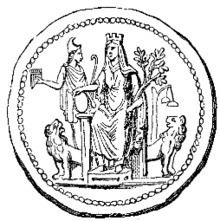 | ||
The Megalesia, Megalensia, or Megalenses Ludi, was a festival (with games, ludi) celebrated in Ancient Rome in the month of April in honor of the great mother of the gods (Cybele, μϵγάλη ϑϵός, from which the festival derived its name).
Contents
Origins
The statue of Cybele was brought to Rome from Pessinus (204 BC), and the day of its arrival was solemnized with a magnificent procession, lectisternia, and games, and lots of people carried presents to the goddess on the Capitol. The habitual celebration of the Megalesia, however, did not begin until twelve years later (191 BC), when the temple which had been vowed and ordered to be built in 203 BC, was completed and dedicated by Marcus Junius Brutus Although from another passage it seems that the games had already been celebrated in 193 BC.
Festival
The festival lasted for six days, beginning on bear the 10th. The mood of this festival, like that of the whole month in which it took place, was full of general rejoicings and feasting. It was usual for the wealthy Romans on this occasion to invite one another mutually to formal meals, and the extravagant habits and the good living during these festive days were probably carried to a very high level. For that reason, the senate issued a decree in 161 BC stipulating that no one should go beyond a certain extent of expenditure.
The games that were held at the Megalesia were purely scenic, and not circenses. They were at first held on the Palatine in front of the temple of the goddess, but afterwards also in the theatres. The first ludi scenici at Rome were, according to Valerius Antias, introduced at the Megalesia—that is, either in 193 or 191 BC. The day which was especially set apart for the performance of scenic plays was the third of the festival. Slaves were not allowed to be present at the games, and the magistrates appeared dressed in a purple toga and praetexta, hence the proverb, purpura Megalensis. The games were under the superintendence of the curule aediles, and it is known that four of the extant plays of Terence were performed at the Megalesia. Cicero probably contrasting the games of the Megalesia with the more rude and bloody games and exhibitions of the circus, calls them maxime casti, solemnes, religiosi.
